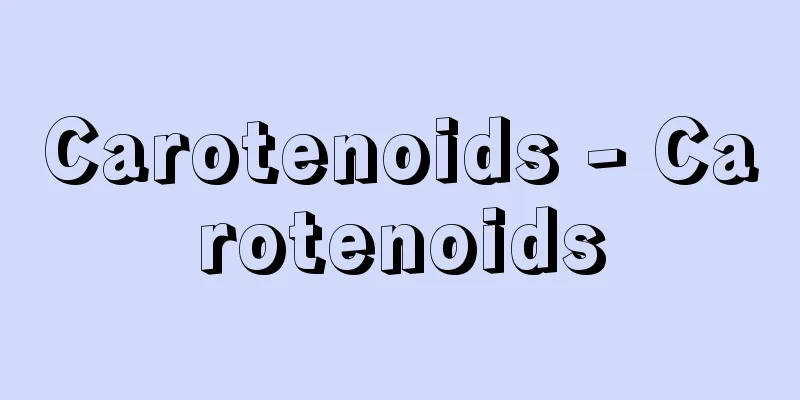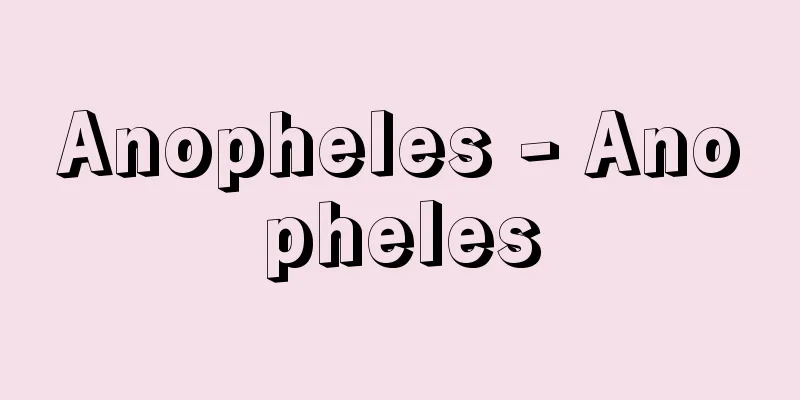Carotenoids - Carotenoids

|
A general term for a group of yellow, orange, and red pigments found widely in the living world. They are also called carotenoids. They have many double bonds in their molecules and are unstable substances that are easily oxidized in air. They are insoluble in water and dissolve well in fat-dissolving solvents such as benzine and ether, which makes them different from flavonoid pigments and betalain pigments of similar colors. There are about 400 types of carotenoids known in nature, but in terms of chemical structure, they belong to isoprenoids (terpenes) and form polyene chains with eight isoprene units with five carbon atoms (polyenes are hydrocarbons with many double bonds). Carotenoids are the only naturally occurring tetraterpenes. Carotenoids are broadly divided into carotenes (carotenes) that consist only of carbon and hydrogen, and xanthophylls that contain oxygen in the terminal ionone (ionone) ring. Carotenes, chemically speaking, are red or reddish purple crystals with β (beta)-ionone rings or groups at both ends, and there are many isomers. The main ones are α (alpha)-carotene, β-carotene, γ (gamma)-carotene, and lycopene. β-carotene is widely distributed as a red pigment in carrot roots and chili peppers, and is also found in large quantities. α-carotene and γ-carotene also coexist with β-carotene in green leaves and carrots. Lycopene is a red pigment found in tomato fruit. Xanthophylls are carotenes with hydroxyl groups or other groups bound to them, and many are known, including zeaxanthin, the yellow pigment in corn seeds, capsanthin, the red pigment in chili peppers, lutein, which gives egg yolks and butter their yellow color and the color of canary feathers, astaxanthin, found in shrimp and crab shells, and fucoxanthin, the brown pigment in brown algae. In higher plants, carotenoids are found together with chlorophyll in the thylakoids (flat, sac-like structures made of proteins and lipids) of chloroplasts, and are also found as crystals in plastids in fruits, flowers, roots, etc. Carotenoids present in chloroplasts function as auxiliary pigments during photosynthesis, absorbing light energy and transferring it to chlorophyll a. Carotenoids also protect cells from damage caused by light. Carotenoids contained in the eyespots and photosensitive spots of flagellates such as Euglena are light-receiving pigments that are involved in phototaxis (the phenomenon in which living organisms move at a certain angle to the direction of light). Animals cannot synthesize carotenoids in their own bodies, so the carotenoids present in animals are derived from the carotenoids in plants they ingest as food. Many animals, including humans, can ingest and absorb both carotenes and xanthophylls, but horses and other animals can only ingest carotenes, while chickens, many fish, and marine invertebrates such as crustaceans can only ingest xanthophylls. When animals ingest carotenes with a β-ionone ring, such as β-carotene, they undergo chemical changes in the body to become vitamin A. Retinol, a vitamin A aldehyde, is a component of the pigment protein rhodopsin and is involved in vision. Of the carotenes with vitamin A activity, β-carotene is the most potent, with the others only having about half the activity. Lycopene in tomatoes has no vitamin A activity whatsoever. Carotenoids are synthesized in the chloroplasts of plants and in chromatophores (small vesicles, pigment cells) of bacteria. Carotenoids are a type of isoprenoid, and therefore are produced in living organisms through the mevalonate pathway common to terpenes. The first carotenoids produced are carotenes, which combine with oxygen from the air to become xanthophylls. Xanthophylls are the pigments that give autumn leaves their yellow color, but generally, as plants age, the carotenes that were present in their youth are oxidized to become xanthophylls. [Seiichi Yoshida and Takao Minamikawa] "Secondary Metabolism of Higher Plants" by Yoshida Seiichi and Minamikawa Takao (1978, University of Tokyo Press)" ▽ "Physiology of Plant Metabolism" by Ishikura Shigeyuki (1987, Morikita Publishing)" ▽ "How to Name Biochemical Substances" by Liao Chunrong (1988, Sankyo Publishing)" ▽ "Carotenoids in Marine Organisms - Metabolism and Biological Activity" edited by Miki Wataru (1993, Koseisha Koseisha)" ▽ "Inorganic Substances and Pigments - Histochemical Techniques" edited by Ogawa Kazuo et al. (1994, Asakura Publishing)" ▽ "The Chemistry of Food Discoloration" edited by Kimura Susumu et al. (1995, Korin Publishing)" ▽ "Encyclopedia of Vitamins" edited by the Vitamin Society of Japan (1996, Asakura Publishing)" ▽ "New Food Ingredients and Functions" edited by the BIO INDUSTRY Editorial Department (1997, CMC)" ▽ "Why does multi-carotene suppress cancer?" by Nishino Sueyoshi and Frederick Kaczyk (1998, Metamor Publishing)" ▽ "There is a reason for the colors of vegetables - the benefits of tomatoes and green and yellow vegetables, continued by Ishiguro Yukio et al. (1999, Mainichi Shimbun)" ▽ "Introduction to plant molecular physiology, by Yokota Akiho (1999, Academic Press Center)" ▽ "Asakura Plant Physiology Lecture 2: Metabolism, edited by Yamatani Tomoyuki (2000, Asakura Publishing)" ▽ "Animal pigments - the world of diverse colors, by Umebachi Yukishige (2000, Uchida Rokakuho)" ▽ "New edition of edible natural pigments, edited by Fujii Masami, by Shimizu Takashige and Nakamura Mikio (2000, Korin)" ▽ "Your body is rusting, so you need multi-carotene, by Shimizu Tomihiro and Togashi Makio (2002, Metamor Publishing)" ▽ "Natural Product Chemistry" edited by Osamu Tanaka et al. (2002, Nanzando) "Food and Color" by Osamu Katayama and Makoto Tajima (2003, Korin) [References] | | | | | | | | | | | | | | | | | |Source: Shogakukan Encyclopedia Nipponica About Encyclopedia Nipponica Information | Legend |
|
生物界に広くみいだされる黄、橙(だいだい)、赤の色をした一群の色素の総称。カロテノイドともいう。分子中に多くの二重結合があって、空気中で酸化されやすく、不安定な物質である。水に不溶で、ベンジン、エーテルなど、脂肪を溶かす溶媒によく溶ける点が、同じような色をしたフラボノイド色素やベタレイン色素と異なる。天然には400種類ほどのカロチノイドが知られているが、これらは化学構造のうえではイソプレノイド(テルペン)に属し、炭素数5のイソプレン単位が8個連なったポリエン鎖をなしている(ポリエンは数多くの二重結合をもつ炭化水素)。天然のテトラテルペン類はカロチノイドのみである。カロチノイドは炭素と水素のみからなるカロチン(カロテン)類と、末端のイオノン(ヨノン)環に酸素を含むキサントフィル類に大別される。 カロチン類は、化学構造的には、両端にβ(ベータ)-イオノン環または基をもつ赤色あるいは赤紫色の結晶で、多くの異性体がある。おもなものにα(アルファ)-カロチン、β-カロチン、γ(ガンマ)-カロチン、リコピンなどがある。β-カロチンはニンジンの根やトウガラシなどの赤い色素として分布が広く、また量的にも多くみいだされる。α-カロチンやγ-カロチンも緑葉やニンジン中にβ-カロチンと共存して含まれる。リコピンはトマトの果実に含まれる赤色の色素である。 キサントフィル類は、カロチン類にヒドロキシ基などが結合したもので、トウモロコシの種子の黄色の色素であるゼアキサンチン、トウガラシの赤色の色素のカプサンチン、卵黄やバターの黄色あるいはカナリアの羽毛の色のもとであるルテイン、エビやカニの殻に含まれるアスタキサンチン、褐藻類の褐色素フコキサンチンなど多数が知られている。 高等植物では、カロチノイドは葉緑体のチラコイド(タンパク質と脂質とでできた扁平(へんぺい)な袋状の構造)にクロロフィルとともに含まれ、また果実、花、根などでは色素体中に結晶となってみられる。葉緑体に存在するカロチノイドは、光合成の際に補助色素として光のエネルギーを吸収して、これをクロロフィルaに受け渡しする役割をしている。またカロチノイドは、細胞が光によって害を受けるのを防ぐ働きをしている。ミドリムシのような鞭毛(べんもう)虫類の眼点や感光点に含まれるカロチノイドは、光を受け取る色素として光走性(ひかりそうせい)(走光性(そうこうせい)。生物が光の方向と一定の角度をもって移動する現象)に関与している。 動物はカロチノイドを自分の体内でつくることができないので、動物に存在するカロチノイドは、食物として摂取した植物のカロチノイドに由来する。ヒトなど多くの動物はカロチン類とキサントフィル類をともに摂取、吸収できるが、ウマなどではカロチン類だけ、ニワトリや多くの魚類、甲殻類などの海産無脊椎(せきつい)動物などは、キサントフィル類しか摂取できない。β-カロチンのようなβ-イオノン環をもったカロチン類は、動物が摂取すると、体内で化学変化を受けてビタミンAとなる。ビタミンAアルデヒドであるレチノールは色素タンパク質ロドプシンの成分として視覚にかかわっている。ビタミンAの活性をもつカロチン類としては、β-カロチンがもっとも効力があり、他はその半分ほどの活性しかない。トマトのリコピンはビタミンAの効力がまったくない。 カロチノイドの合成は植物では葉緑体中で、細菌ではクロマトフォア(小胞、色素胞)中でおこる。カロチノイドは、イソプレノイドの一種であり、したがって、生体内ではテルペン類に共通のメバロン酸経路でつくられる。最初につくられるカロチノイドはカロチン類で、これに空気中の酸素が結合してキサントフィル類に変わる。秋の黄葉の色素はキサントフィルであるが、一般に植物が老化すると、若い時期にあったカロチン類が酸化されてキサントフィル類となる。 [吉田精一・南川隆雄] 『吉田精一・南川隆雄著『高等植物の二次代謝』(1978・東京大学出版会)』▽『石倉成行著『植物代謝生理学』(1987・森北出版)』▽『廖春栄著『生化学物質名称のつけ方』(1988・三共出版)』▽『幹渉編『海洋生物のカロテノイド――代謝と生物活性』(1993・恒星社厚生閣)』▽『小川和朗他編『無機物と色素――組織細胞化学の技術』(1994・朝倉書店)』▽『木村進他編著『食品の変色の化学』(1995・光琳)』▽『日本ビタミン学会編『ビタミンの事典』(1996・朝倉書店)』▽『BIO INDUSTRY編集部編『新しい食品素材と機能』(1997・シーエムシー)』▽『西野輔翼、フレデリック・カチック著『なぜマルチカロチンがガンを抑制するのか』(1998・メタモル出版)』▽『石黒幸雄他著『続・野菜の色には理由がある――トマト&緑黄野菜の効用』(1999・毎日新聞社)』▽『横田明穂著『植物分子生理学入門』(1999・学会出版センター)』▽『山谷知行編『朝倉植物生理学講座2 代謝』(2000・朝倉書店)』▽『梅鉢幸重著『動物の色素――多様な色彩の世界』(2000・内田老鶴圃)』▽『藤井正美監修、清水孝重・中村幹雄著『新版・食用天然色素』(2000・光琳)』▽『清水富弘・富樫牧夫著『体が錆びているあなたはマルチカロチンが必要です』(2002・メタモル出版)』▽『田中治他編『天然物化学』(2002・南江堂)』▽『片山脩・田島真著『食品と色』(2003・光琳)』 [参照項目] | | | | | | | | | | | | | | | | | |出典 小学館 日本大百科全書(ニッポニカ)日本大百科全書(ニッポニカ)について 情報 | 凡例 |
>>: Garo tribe - Garo (English spelling)
Recommend
International Monetary Fund
…The abbreviation for the International Monetary ...
Shimaya Ichizaemon
?-1690 An explorer in the early Edo period. He le...
Flower sesame - Flower sesame
...The game was played in a violent way, with pla...
Long-tailed mouse - Onagaji mouse
...It is found only in Japan and Jeju Island, and...
Leather-bound short armor
…Formal name of armor. In the Todaiji Temple Offe...
Luis M. Sánchez Cerro
1889‐1933 Peruvian soldier and politician. In Augu...
Greenwich time - Greenwich time (English spelling)
Its official name is Greenwich Mean Time, and its ...
Stem family
...Indian matrilineal extended families are simil...
Turtle leaf beetle - Turtle leaf beetle
This insect belongs to the family Chrysomelidae, ...
Echo - Kodama
Spirits that reside in trees. Also refers to the ...
Ball riding - Tamanori
A type of acrobatics. Performers ride on large bal...
Dayflower
...Blue paper dyed with the juice of flowers cont...
Chinese Revolutionary Party
A secret revolutionary society organized by Sun Y...
North America - Kitaamerika (English spelling) North America
A name used to divide the Americas. When the cont...
sense-datum
...This idea was developed by logical positivism ...









